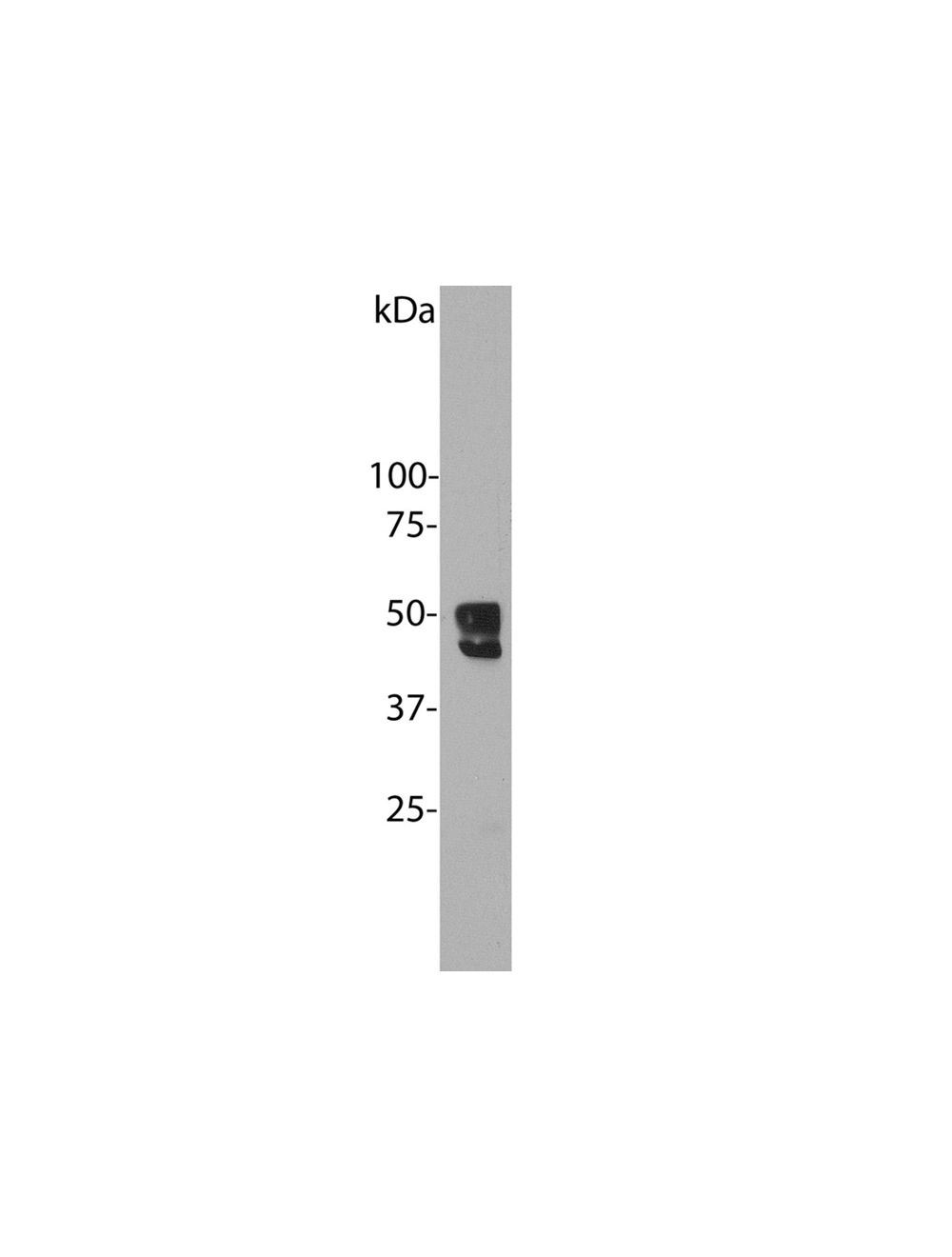Ataxin-2 binding protein 1 (A2BP1/Fox1), Mouse Monoclonal Antibody
As low as
US$317.00
Only %1 left
Catalog Number
M-1688
- Product Name Ataxin-2 binding protein 1 (A2BP1/Fox1), Mouse Monoclonal Antibody
-
Product Description
Mouse anti-Ataxin-2 binding protein 1 (A2BP1) Monoclonal Antibody (Unconjugated), suitable for WB, IHC-Frozen.
- Alternative Names ataxin-2 binding protein 1 (A2BP1); RNA binding protein fox-1 homolog 1
- Application(s) IHC-Frozen, WB
- Antibody Host Mouse
- Antibody Type Monoclonal
- Specificity The antibody reacts with a 48 kDa and 46 kDa band by Western blot on extract from mouse brain. It has also been used successfully for immunocytochemistry on rat neuronal cultures.
- Species Reactivity Human, Mouse, Rat
- Immunogen Description N-terminal 100 amino acids of human Fox1 as expressed in and purified from E. coli.
- Conjugate Unconjugated
- Purity Description Protein G purified
- Regulatory Status For research use only.
Product Info
-
Product Description
Mouse anti-Ataxin-2 binding protein 1 (A2BP1) Monoclonal Antibody (Unconjugated), suitable for WB, IHC-Frozen.
- Application(s) IHC-Frozen, WB
- Application Details Immunocytochemistry (IHC) and Western Blotting (WB). A dilution of 1:1,000-1:2,000 is recommended for WB. A dilution of 1:500-1:1000 is recommended for ICC. The optimal dilution should be determined by the end user.
- Target Ataxin-2 binding protein 1 (A2BP1)
- Specificity The antibody reacts with a 48 kDa and 46 kDa band by Western blot on extract from mouse brain. It has also been used successfully for immunocytochemistry on rat neuronal cultures.
- Target Host Species Human
- Species Reactivity Human, Mouse, Rat
- Antibody Host Mouse
- Antibody Type Monoclonal
- Antibody Isotype IgG1
- Clone Name 1G10
- Conjugate Unconjugated
- Immunogen Description N-terminal 100 amino acids of human Fox1 as expressed in and purified from E. coli.
- Purity Description Protein G purified
- Format Lyophilized from PBS buffer pH 7.2-7.6 with 0.1% trehalose, and sodium azide
- Reconstitution Instructions Spin vial briefly before opening. Reconstitute with 100 µL sterile-filtered, ultrapure water to achieve a 1 mg/mL concentration. Centrifuge to remove any insoluble material.
- Storage Instructions After reconstitution of lyophilized antibody, aliquot and store at -20°C for a higher stability. Avoid freeze-thaw cycles.
- Batch Number Please see item label.
- Expiration Date 12 months after date of receipt (unopened vial).
- Alternative Names ataxin-2 binding protein 1 (A2BP1); RNA binding protein fox-1 homolog 1
- Uniprot Number Q9NWB1
- Uniprot Number/Name Q9NWB1 (RFOX1_HUMAN)
- Scientific Background Fox1 is one of a family of 3 mammalian Fox1 homologues. Fox1 was discovered in C. elegans as a gene involved in sex determination, and the name Fox is an acronym of "Feminizing locus on X" (1). The C. elegans Fox1 protein and its 3 mammalian homologues are all about 46 kDa proteins and each includes a central highly conserved RRM type RNA recognition motif, which corresponds to a small ~70 amino acid structure consisting of 4 beta strands and two alpha-helices. This region is identical in all three mammalian Fox1 family proteins. An alternate name for Fox 1 is ataxin-2 binding protein 1 (A2BP1), since it was discovered in a yeast two hybrid screen using ataxin-2 as bait (2). As with the other Fox proteins, it is assumed that Fox1/A2BP1 has a role in the RNA splicing in the nervous system (3). Fox3, a protein also known as NeuN, is a widely used marker of neuronal nuclei and proximal cytoplasm (4, 5). Like Fox3, Fox1 is expressed in neuronal nuclei, but with a different pattern of expression than Fox3. For example, in the cerebellum Fox3 does not stain Purkinje neurons and Golgi neurons, but these two neuron types are stained by Fox1 antibody (6).
- Shipping Temperature 25°C (ambient)
- UNSPSC CODE 41116161
- Regulatory Status For research use only.
Specifications
- General References Hodgkin J, Zellan JD, Albertson DG. Identification of a candidate primary sex determination locus, fox-1, on the X chromosome of Caenorhabditis elegans. Development 120:3681-3689 (1994).Shibata H, Huynh DP, Pulst SM. A novel protein with RNA-binding motifs interacts with ataxin-Hum Mol Genet. 39:1303-13 (2000).Underwood JG, Boutz PL, Dougherty JD, Stoilov P and Black DL. Homologues of the Caenorhabditis elegans Fox-1 protein are neuronal splicing regulators in mammals. Mol. Cell. Biol. 25:10005-10016 (2005).Mullen RJ, Buck CR, Smith AM. NeuN, a neuronal specific nuclear protein in vertebrates. Development 116:201-211 (1994).Kim KK, Adelstein RS, Kawamoto S. Identification of neuronal nuclei (NeuN) as Fox-3, a new member of the Fox-1 gene family of splicing factors. J. Biol. Chem. 284:31052-31061 (2009).Kim KK, Kim YC, Adelstein RS, Kawamoto S. Fox-3 and PSF interact to activate neural cell-specific alternative splicing. Nucleic Acids Res. 39:3064-78 (2011).

 1800 605-5127
1800 605-5127 +61 (0)8 8352 7711
+61 (0)8 8352 7711


